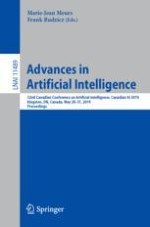2019 | Buch
Advances in Artificial Intelligence
32nd Canadian Conference on Artificial Intelligence, Canadian AI 2019, Kingston, ON, Canada, May 28–31, 2019, Proceedings
herausgegeben von: Marie-Jean Meurs, Frank Rudzicz
Verlag: Springer International Publishing
Buchreihe : Lecture Notes in Computer Science
